| 1950 |
|
| 1950 |
 Alan Turing proposes the Turing Test criterion for an intelligent machine.
Alan Turing proposes the Turing Test criterion for an intelligent machine.
|
| 1951 |
 John Eckert & John Mauchly finish UNIVAC 1, the first mass-produced electronic
computer.
John Eckert & John Mauchly finish UNIVAC 1, the first mass-produced electronic
computer.
|
|
 Coronado Corporation changes its name to Texas Instruments Inc.
Coronado Corporation changes its name to Texas Instruments Inc.

|
| 1952 |
 The IBM 701 goes into production. Multiplication: 0.4 ms.
The IBM 701 goes into production. Multiplication: 0.4 ms.
|
|
 Heinz Nixdorf founds the Labor für Impulstechnik.
Heinz Nixdorf founds the Labor für Impulstechnik.
|
| 1953 |
 Jay Forrester invents the (ceramic ferrite) core memory.
Jay Forrester invents the (ceramic ferrite) core memory.
|
| 1954 |
 Texas Instruments announces the start of commercial production of silicon transistors (May).
Texas Instruments announces the start of commercial production of silicon transistors (May).
|
|
 Jack Tramiel founds Commodore Business Machines as a typewriter repair service.
Jack Tramiel founds Commodore Business Machines as a typewriter repair service.

|
| 1955 |
 William Shockley founds Shockley Semiconductor in Palo Alto, California.
William Shockley founds Shockley Semiconductor in Palo Alto, California.
|
| 1956 |
 The Nobel Prize in physics is awarded to John Bardeen, Walter Brattain, and William Shockley
for their work on the transistor.
The Nobel Prize in physics is awarded to John Bardeen, Walter Brattain, and William Shockley
for their work on the transistor.
|
|
 The world's first fully transitorized computer is completed, the TX-O (Transistorized
Experimental Computer), at the Massachusetts Institute of Technology.
The world's first fully transitorized computer is completed, the TX-O (Transistorized
Experimental Computer), at the Massachusetts Institute of Technology.
|
|
 IBM introduces the RAMAC 305, the first hard drive, with 50 two-foot diameter platters.
Total capacity is 5 MB (November).
IBM introduces the RAMAC 305, the first hard drive, with 50 two-foot diameter platters.
Total capacity is 5 MB (November).
|
| 1957 |
 Digital Equipment Corp. (DEC) is founded (August).
Digital Equipment Corp. (DEC) is founded (August).

|
|
 John Backus, et. al. design FORTRAN (FORmula TRANslator).
John Backus, et. al. design FORTRAN (FORmula TRANslator).
|
|
 IBM introduces the IBM 608, the first all-transistor commercial calculator.
IBM introduces the IBM 608, the first all-transistor commercial calculator.
|
|
 A group of eight engineers leave William Shockley's company to form
Fairchild Semiconductors.
A group of eight engineers leave William Shockley's company to form
Fairchild Semiconductors.

|
| 1958 |
 Robert N. Noyce & Jack St. L. Kilby (USA) make the first integrated circuit, an
RC oscillator. It contains five components on a piece of germanium half an inch long and
thinner than a toothpick (September).
Robert N. Noyce & Jack St. L. Kilby (USA) make the first integrated circuit, an
RC oscillator. It contains five components on a piece of germanium half an inch long and
thinner than a toothpick (September).
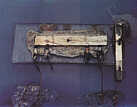
|
| 1959 |
 first planar transistor
first planar transistor
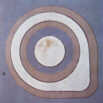
|
|
 LISP (LISt Processing) is implemented by McCarthy at the MIT.
LISP (LISt Processing) is implemented by McCarthy at the MIT.
|
|
 IBM's first fully transistorized computers: IBM 1401 and 1620
IBM's first fully transistorized computers: IBM 1401 and 1620
|
|
 COBOL (COmmon Business Oriented Language) is developed on behalf of the
Department of Defense.
COBOL (COmmon Business Oriented Language) is developed on behalf of the
Department of Defense.
|
|
 At Fairchild Semiconductor, Robert Noyce constructs an integrated circuit with components
connected by aluminum lines on a silicon-oxide surface layer on a plane of silicon.
At Fairchild Semiconductor, Robert Noyce constructs an integrated circuit with components
connected by aluminum lines on a silicon-oxide surface layer on a plane of silicon.
|
| 1960 |
|
| 1960 |
 Theodore Maiman builds the first laser (Light Amplification by Stimulated
Emission of Radiation).
Theodore Maiman builds the first laser (Light Amplification by Stimulated
Emission of Radiation).
|
|
 IBM develops the first automatic mass-production facility for transistors, in New York.
IBM develops the first automatic mass-production facility for transistors, in New York.
|
|
 Digital Equipment Corp. introduces the minicomputer, the PDP-1, for US$120,000.
It is the first commercial computer equipped with a keyboard and monitor.
PDP stands for Program, Data, Processor.
Digital Equipment Corp. introduces the minicomputer, the PDP-1, for US$120,000.
It is the first commercial computer equipped with a keyboard and monitor.
PDP stands for Program, Data, Processor.
|
|
 C. Hoare programs the Quicksort algorithm.
C. Hoare programs the Quicksort algorithm.
|
|
 first MOS transistor from Fairchild (MOS = Metal Oxide Semiconductor)
first MOS transistor from Fairchild (MOS = Metal Oxide Semiconductor)
|
| 1961 |
 Burroughs Company introduces multiprogramming and virtual memory.
Burroughs Company introduces multiprogramming and virtual memory.
|
|
 Fairchild Semiconductor releases the first commercial integrated circuit.
Fairchild Semiconductor releases the first commercial integrated circuit.
|
| 1962 |
 K. E. Iverson develops APL (A Programming Language).
K. E. Iverson develops APL (A Programming Language).
|
|
 Douglas Engelbart invents the mouse pointing device for computers.
Douglas Engelbart invents the mouse pointing device for computers.
|
| 1963 |
 Charles Tandy buys the RadioShack Corporation (April). The Tandy Radio
Shack company will become one of the main producers of home computers in the late 1970s.
Charles Tandy buys the RadioShack Corporation (April). The Tandy Radio
Shack company will become one of the main producers of home computers in the late 1970s.


|
|
 Douglas Engelbart receives a patent on the mouse pointing device for computers.
Douglas Engelbart receives a patent on the mouse pointing device for computers.
|
| 1964 |
 John Kemeny and Thomas Kurtz develop the BASIC programming language at Dartmouth
College. BASIC is an acronym for Beginners All-purpose Symbolic Instruction Code. BASIC
becomes the most popular introductory programming language for microcomputers, often stored
in ROM, and executing commands interactively.
John Kemeny and Thomas Kurtz develop the BASIC programming language at Dartmouth
College. BASIC is an acronym for Beginners All-purpose Symbolic Instruction Code. BASIC
becomes the most popular introductory programming language for microcomputers, often stored
in ROM, and executing commands interactively.
|
|
 IBM introduces the System/360.
IBM introduces the System/360.
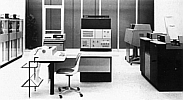
|
|
 Sperry introduces the UNIVAC 1108.
Sperry introduces the UNIVAC 1108.

|
|
 Texas Instruments receives a patent on the integrated circuit.
Texas Instruments receives a patent on the integrated circuit.
|
|
 The American Standard Association adopts ASCII (American Standard Code for Information
Interchange) as a standard code for data transfer. This standard, defining 7-bit character
codes, will be used for most personal computers in the Western world.
The American Standard Association adopts ASCII (American Standard Code for Information
Interchange) as a standard code for data transfer. This standard, defining 7-bit character
codes, will be used for most personal computers in the Western world.
|
|
 IBM coins the term word processing.
IBM coins the term word processing.
|
| 1965 |
 Digital Equipment Corp. introduces the PDP-8.
Digital Equipment Corp. introduces the PDP-8.
|
|
 first analog integrated circuit: µA 709
first analog integrated circuit: µA 709

|
|
 Gordon Moore, head of research and development for Fairchild Semiconductor, predicts that
transistor density on integrated circuits would double every 12 months for the next ten
years. This prediction is revised in 1975 to doubling every 24 months, and becomes known
as Moore's Law.
Gordon Moore, head of research and development for Fairchild Semiconductor, predicts that
transistor density on integrated circuits would double every 12 months for the next ten
years. This prediction is revised in 1975 to doubling every 24 months, and becomes known
as Moore's Law.
|
| 1966 |
 Joseph Weizenbaum (MIT)
Joseph Weizenbaum (MIT)
 programs Eliza.
programs Eliza.
|
|
 Hewlett-Packard starts manufacturing computers.
Hewlett-Packard starts manufacturing computers.
|
|
 Steven Gray founds the Amateur Computer Society, and begins publishing the
ACS Newsletter. Some consider this to be the birth-date of personal computing (May).
Steven Gray founds the Amateur Computer Society, and begins publishing the
ACS Newsletter. Some consider this to be the birth-date of personal computing (May).
|
|
 AT&T Bell Labs announces the invention of magnetic bubble memory.
AT&T Bell Labs announces the invention of magnetic bubble memory.

|
| 1967 |
 The first Consumer Electronics Show is held in New York City.
The first Consumer Electronics Show is held in New York City.
|
|
 The first electronic desktop calculator, the Anita Mark VIII by Norman Kitz (England).
The first electronic desktop calculator, the Anita Mark VIII by Norman Kitz (England).
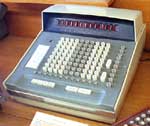
|
|
 The DATEX network is started up in Germany.
The DATEX network is started up in Germany.
|
| 1968 |
 Robert Noyce & Gordon Moore leave Fairchild Semiconductors and found Integrated
Electronics (Intel). Intel begins as a memory chip producer, but will soon switch to the
new field of microprocessors.
Robert Noyce & Gordon Moore leave Fairchild Semiconductors and found Integrated
Electronics (Intel). Intel begins as a memory chip producer, but will soon switch to the
new field of microprocessors.

|
|
 Niklaus Wirth
Niklaus Wirth
 develops Pascal.
develops Pascal.
|
|
 International Research Corp., in San Martin, California, develops the architecture for a
computer-on-a-chip modelled on an enhanced PDP-8/S concept. Until now, the CPU (central
processing unit) has been a collection of chips and other components on a circuit board.
Moving as many as possible onto a single chip will greatly aid miniaturization, reduce costs,
and increase speed (February).
International Research Corp., in San Martin, California, develops the architecture for a
computer-on-a-chip modelled on an enhanced PDP-8/S concept. Until now, the CPU (central
processing unit) has been a collection of chips and other components on a circuit board.
Moving as many as possible onto a single chip will greatly aid miniaturization, reduce costs,
and increase speed (February).
|
|
 Ed Roberts & Forest Mims found Micro Instrumentation Telemetry Systems (MITS).
In a few years, MITS will make a desperate switch from producing calculators to computers,
and begin a revolution in hobbyist computing.
Ed Roberts & Forest Mims found Micro Instrumentation Telemetry Systems (MITS).
In a few years, MITS will make a desperate switch from producing calculators to computers,
and begin a revolution in hobbyist computing.

|
|
 Nixdorf AG is founded.
Nixdorf AG is founded.

|
|
 The US Patent & Trademark Office grants patent 3,387,286 to Dr. Robert Dennard, of the
IBM T.J. Watson Research Center. The patent is for a one-transistor DRAM cell and the basic
idea in the three-transistor cell (June).
The US Patent & Trademark Office grants patent 3,387,286 to Dr. Robert Dennard, of the
IBM T.J. Watson Research Center. The patent is for a one-transistor DRAM cell and the basic
idea in the three-transistor cell (June).
|
|
 Douglas C. Engelbart, of the Stanford Research Institute, demonstrates his system of keyboard,
keypad, mouse, and windows at the Joint Computer Conference in San Francisco's Civic Center.
He demonstrates use of a word processor, a hypertext system, and remote collaborative work
with colleagues.
Douglas C. Engelbart, of the Stanford Research Institute, demonstrates his system of keyboard,
keypad, mouse, and windows at the Joint Computer Conference in San Francisco's Civic Center.
He demonstrates use of a word processor, a hypertext system, and remote collaborative work
with colleagues.
|
| 1969 |
 Jerry Sanders and seven others leave Fairchild Semiconductor to form Advanced Micro Devices
(AMD).
Jerry Sanders and seven others leave Fairchild Semiconductor to form Advanced Micro Devices
(AMD).

|
|
 Seymour Cray of Control Data
Seymour Cray of Control Data
 builds the CDC 7600, the first supercomputer.
builds the CDC 7600, the first supercomputer.
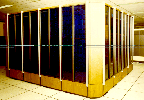
|
|
 Dennis Ritchie & Kenneth Thompson begin work on the UNIX operation system.
Dennis Ritchie & Kenneth Thompson begin work on the UNIX operation system.
|
|
 US DoD (ARPA): first sites connected via the Arpanet.
US DoD (ARPA): first sites connected via the Arpanet.
|
|
 XEROX opens the Palo Alto Research Center (PARC).
XEROX opens the Palo Alto Research Center (PARC).

|
|
 Bill Gates & Paul Allen, calling themselves the "Lakeside Programming Group",
sign an agreement with Computer Center Corporation to report bugs in PDP-10 software,
in exchange for computer time.
Bill Gates & Paul Allen, calling themselves the "Lakeside Programming Group",
sign an agreement with Computer Center Corporation to report bugs in PDP-10 software,
in exchange for computer time.
|
|
 Gary Starkweather, at Xerox's research facility in Webster, New York, demonstrates using
a laser beam with the xerography process to create a laser printer.
Gary Starkweather, at Xerox's research facility in Webster, New York, demonstrates using
a laser beam with the xerography process to create a laser printer.
|
| 1970 |
|
|
| 1970 |
 Intel creates the 1103 chip, the first generally available 1024-bit dynamic
RAM memory chip.
Intel creates the 1103 chip, the first generally available 1024-bit dynamic
RAM memory chip.
|
|
 Fairchild introduced the first 256-bit static RAM called the 4100.
Fairchild introduced the first 256-bit static RAM called the 4100.
|
| 1971 |
 Intel introduces the first microprocessor, the Intel 4004.
Clock speed of the CPU is 108 kHz. Performance is 60,000 operations per second. It uses
2300 transistors on a die of 3x4 mm, based on 10-micron technology. It can address
640 bytes. Initial price is US$200. Documentation manuals were written by Adam Osborne.
Intel introduces the first microprocessor, the Intel 4004.
Clock speed of the CPU is 108 kHz. Performance is 60,000 operations per second. It uses
2300 transistors on a die of 3x4 mm, based on 10-micron technology. It can address
640 bytes. Initial price is US$200. Documentation manuals were written by Adam Osborne.

|
|
 In major trade publications including Electronic News, Intel officially introduces the MCS-4
(Microcomputer System 4-bit) microcomputer system. It is comprised of the 4001 ROM chip,
4002 RAM chip, 4003 shift register chip, and the 4004 microprocessor.
In major trade publications including Electronic News, Intel officially introduces the MCS-4
(Microcomputer System 4-bit) microcomputer system. It is comprised of the 4001 ROM chip,
4002 RAM chip, 4003 shift register chip, and the 4004 microprocessor.
|
|
 Nolan Bushnell founds Atari.
Nolan Bushnell founds Atari.

|
|
 Stephen Wozniak &ill Fernandez build a computer with lights and switches, from parts
rejected by local companies. They call it the Cream Soda Computer, as they
drank Cragmont cream soda while they worked.
Stephen Wozniak &ill Fernandez build a computer with lights and switches, from parts
rejected by local companies. They call it the Cream Soda Computer, as they
drank Cragmont cream soda while they worked.
|
|
 IBM introduces the memory disk, or floppy disk, an 8-inch floppy plastic
disk coated with iron oxide.
IBM introduces the memory disk, or floppy disk, an 8-inch floppy plastic
disk coated with iron oxide.
|
|
 Intel introduces the 1101 chip, a 256-bit programmable memory (PROM),
and the 1701 chip, a 256-byte erasable read-only memory (EROM).
Intel introduces the 1101 chip, a 256-bit programmable memory (PROM),
and the 1701 chip, a 256-byte erasable read-only memory (EROM).
|
|
 Wang
Wang
 introduces the Wang 1200 word processor system.
introduces the Wang 1200 word processor system.
|
| 1972 |
 Texas Instruments unveils its first line of electronic calculators, the TI-2500
Texas Instruments unveils its first line of electronic calculators, the TI-2500
 ,
TI-3000, and TI-3500 ,
TI-3000, and TI-3500
 (September) (September)
|
|
 The Pioneer 10 spacecraft is launched, powered by Intel 4004 computing power
(March, 2).
The Pioneer 10 spacecraft is launched, powered by Intel 4004 computing power
(March, 2).
|
|
 National Semiconductor
National Semiconductor
 introduces the IMP-16 microprocessor
introduces the IMP-16 microprocessor
|
|
 Intel introduces its 200-KHz 8008 chip, the first commercial 8-bit microprocessor,
part of the MCS-8 product family of chips. It accesses 16 KB of memory. It uses 3500
transistors, based on 10-micron technology. Speed is 60,000 instructions per second (April).
Intel introduces its 200-KHz 8008 chip, the first commercial 8-bit microprocessor,
part of the MCS-8 product family of chips. It accesses 16 KB of memory. It uses 3500
transistors, based on 10-micron technology. Speed is 60,000 instructions per second (April).

|
|
 Rockwell announces the PPS-4 microprocessor family, similar to Intel's MCS-4.
Rockwell announces the PPS-4 microprocessor family, similar to Intel's MCS-4.

|
|
 Gary Kildall implements PL/1 on the Intel 4004 processor.
Gary Kildall implements PL/1 on the Intel 4004 processor.
|
|
 Xerox decides to build a personal computer to be used for research. The result is
the Alto computer.
Xerox decides to build a personal computer to be used for research. The result is
the Alto computer.
|
|
 Hewlett-Packard introduces the HP-35, the first scientific hand-held calcuator.
Hewlett-Packard introduces the HP-35, the first scientific hand-held calcuator.

|
|
 Bill Gates & Paul Allen form the Traf-O-Data company. They had developed an
8008-based computer hardware/software system for recording automobile traffic flow on a highway.
Bill Gates & Paul Allen form the Traf-O-Data company. They had developed an
8008-based computer hardware/software system for recording automobile traffic flow on a highway.
|
|
 At Texas Instruments, Gary Boone and Michael Cochran create the TMS1000 one-chip
microcomputer. It integrates 1 KB ROM and 32 bytes of RAM with a simple 4-bit processor.
At Texas Instruments, Gary Boone and Michael Cochran create the TMS1000 one-chip
microcomputer. It integrates 1 KB ROM and 32 bytes of RAM with a simple 4-bit processor.
|
| 1973 |
 Gary Kildall writes a simple operating system in his PL/1 language.
He calls it CP/M (Control Program for Microcomputers).
Gary Kildall writes a simple operating system in his PL/1 language.
He calls it CP/M (Control Program for Microcomputers).
|
|
 Stephen Wozniak joins Hewlett-Packard.
Stephen Wozniak joins Hewlett-Packard.
|
|
 IBM introduces the IBM 3340 hard disk unit, known as the Winchester,
IBM's internal development code name. It used four 8-inch diameter platters, giving it
a capacity of 70 MB.
IBM introduces the IBM 3340 hard disk unit, known as the Winchester,
IBM's internal development code name. It used four 8-inch diameter platters, giving it
a capacity of 70 MB.
|
|
 Digital Equipment introduces the PDP-8A with 1KB memory for US$875.
Digital Equipment introduces the PDP-8A with 1KB memory for US$875.
|
|
 Bob Metcalfe invents the Ethernet connectivity system.
Bob Metcalfe invents the Ethernet connectivity system.
|
|
 Xerox builds the Alto workstation computer at its Palo Alto Research Center.
It uses the advanced Smalltalk language, a mouse input device, and the
Ethernet technique of linking Alto computers to each other. Less than 2000 are built in total.
Xerox builds the Alto workstation computer at its Palo Alto Research Center.
It uses the advanced Smalltalk language, a mouse input device, and the
Ethernet technique of linking Alto computers to each other. Less than 2000 are built in total.
|
|
 the first integrated 4kbit memory, a dynamic RAM
the first integrated 4kbit memory, a dynamic RAM
|
|
 In France, R2E introduces the Micral microcomputer, powered by an Intel 8008
microprocessor. It is the first commercial non-kit computer based on a microprocessor.
The term "microcomputer" is first used in print in reference to the Micral.
In France, R2E introduces the Micral microcomputer, powered by an Intel 8008
microprocessor. It is the first commercial non-kit computer based on a microprocessor.
The term "microcomputer" is first used in print in reference to the Micral.
|
|
 Gary Kildall creates the PL/M programming language for the Intel 8008, based on PL/I.
Gary Kildall creates the PL/M programming language for the Intel 8008, based on PL/I.
|
| 1974 |
 Intel releases its 2-MHz 8080 chip, an 8-bit microprocessor. It can access 64KB of
memory and uses 6000 transistors (April).
Intel releases its 2-MHz 8080 chip, an 8-bit microprocessor. It can access 64KB of
memory and uses 6000 transistors (April).
|
|
 Motorola introduces its 6800 chip, an early 8-bit microprocessor used in
microcomputers and industrial and automotive control devices. The 6800 was designed by
Chuck Peddle and Charlie Melear.
Motorola introduces its 6800 chip, an early 8-bit microprocessor used in
microcomputers and industrial and automotive control devices. The 6800 was designed by
Chuck Peddle and Charlie Melear.

|
|
 National Semiconductor introduces the 16-bit IMP-16 microprocessor.
National Semiconductor introduces the 16-bit IMP-16 microprocessor.
|
|
 Creative Computing, the first magazine for home computerists, is founded (September).
Creative Computing, the first magazine for home computerists, is founded (September).

|
|
 Bill Mensch, Chuck Peddle, and others leave Motorola to work for MOS Technology
(August).
Bill Mensch, Chuck Peddle, and others leave Motorola to work for MOS Technology
(August).
|
|
 Despite being US$300,000 in debt, Ed Roberts is able to borrow an additional US$65,000 from
the bank to complete work on what would be the Altair (September).
Despite being US$300,000 in debt, Ed Roberts is able to borrow an additional US$65,000 from
the bank to complete work on what would be the Altair (September).
|
|
 Hal Chamberlin and others begin publishing The Computer Hobbyist magazine (November).
Hal Chamberlin and others begin publishing The Computer Hobbyist magazine (November).
|
|
 Popular Electronics publishes an article by MITS announcing the Altair 8800 computer
for US$439 in kit form. It uses the Intel 8080 processor. The Altair pictured on the cover
of the magazine is actually a mock-up, as an actual computer was not available.
Les Solomon, publisher of Popular Electronics, receives Altair number 0001.
Lauren Solomon, 12 year old daughter of Les Solomon, suggests the name "Altair"
for Ed Robert's new microcomputer. Altair VI was the name of where Star Trek's Enterprise
was going that night (December) .
Popular Electronics publishes an article by MITS announcing the Altair 8800 computer
for US$439 in kit form. It uses the Intel 8080 processor. The Altair pictured on the cover
of the magazine is actually a mock-up, as an actual computer was not available.
Les Solomon, publisher of Popular Electronics, receives Altair number 0001.
Lauren Solomon, 12 year old daughter of Les Solomon, suggests the name "Altair"
for Ed Robert's new microcomputer. Altair VI was the name of where Star Trek's Enterprise
was going that night (December) .
|
|
 Texas Instruments introduces the TMS1000 one-chip microcomputer.
Texas Instruments introduces the TMS1000 one-chip microcomputer.
|
|
 Gary Kildall, of Microcomputer Applications Associates, develops the CP/M operating system
(Control Program/Monitor) in his PL/M language for Intel 8080-based systems.
Gary Kildall, of Microcomputer Applications Associates, develops the CP/M operating system
(Control Program/Monitor) in his PL/M language for Intel 8080-based systems.
|
|
 Brian Kernighan & Dennis Ritchie develop the C programming language.
Brian Kernighan & Dennis Ritchie develop the C programming language.
|
|
 RCA presents the 1802, running at a blazing 6.4 MHz, considered one of
the first RISC chips.
RCA presents the 1802, running at a blazing 6.4 MHz, considered one of
the first RISC chips.

|
|
 Xerox releases the Alto computer.
Xerox releases the Alto computer.
|
| 1975 |
 Paul Allen meets with Ed Roberts to demonstrate the newly written
BASIC interpreter for the Altair. Despite never having touched an Altair before,
the BASIC works flawlessly (February).
Paul Allen meets with Ed Roberts to demonstrate the newly written
BASIC interpreter for the Altair. Despite never having touched an Altair before,
the BASIC works flawlessly (February).
|
|
 Bill Gates & Paul Allen license their newly written BASIC to MITS,
their first customer. This is the first computer language program written for a
personal computer. (February)
Bill Gates & Paul Allen license their newly written BASIC to MITS,
their first customer. This is the first computer language program written for a
personal computer. (February)
|
|
 MITS releases the Altair 8800 personal computer.
MITS releases the Altair 8800 personal computer.
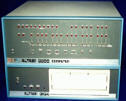
|
|
 Bill Gates & Paul Allen
Bill Gates & Paul Allen
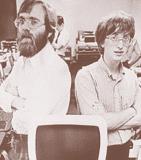 found Micro-Soft, the hyphen is later dropped (April).
found Micro-Soft, the hyphen is later dropped (April).

|
|
 first implementations of relational data bases: Magnum on DECsystem 10 and
Nomad on IBM 370/168
first implementations of relational data bases: Magnum on DECsystem 10 and
Nomad on IBM 370/168
|
|
 MOS Technology announces the MC6501 processor for US$20 and the MC6502
for US$25 (June).
MOS Technology announces the MC6501 processor for US$20 and the MC6502
for US$25 (June).
|
|
 Wayne Green founds BYTE Magazine.
Wayne Green founds BYTE Magazine.
 The first issue is published in September.
The first issue is published in September.

|
|
 IMSAI announces the IMSAI 8080 microcomputer, a clone of the Altair 8800.
IMSAI announces the IMSAI 8080 microcomputer, a clone of the Altair 8800.
|
|
 Bill Gates & Paul Allen sign a licensing agreement with MITS, for their implementation
of the BASIC language. Gates and Allen receive US$3,000 immediately, with royalties of $30
per copy of 4K BASIC, and $35 for 8K BASIC (July, 22).
Bill Gates & Paul Allen sign a licensing agreement with MITS, for their implementation
of the BASIC language. Gates and Allen receive US$3,000 immediately, with royalties of $30
per copy of 4K BASIC, and $35 for 8K BASIC (July, 22).
|
|
 IBM's Entry Level Systems unit unveils the IBM 5100 Portable Computer. It is a
briefcase-size minicomputer with BASIC, 16 KB RAM expandable to 64 KB, tape storage drive
holding 204 KB per tape, keyboard, and built-in 5-inch screen.
Weight: 55 pounds. Code name during development was Project Mercury (September).
IBM's Entry Level Systems unit unveils the IBM 5100 Portable Computer. It is a
briefcase-size minicomputer with BASIC, 16 KB RAM expandable to 64 KB, tape storage drive
holding 204 KB per tape, keyboard, and built-in 5-inch screen.
Weight: 55 pounds. Code name during development was Project Mercury (September).
|
|
 Bill Gates writes an open letter to microcomputer hobbyists, complaining about software piracy,
to be published in an Altair newsletter (December).
Bill Gates writes an open letter to microcomputer hobbyists, complaining about software piracy,
to be published in an Altair newsletter (December).
|
|
 Intel's 8048 is the first single chip microcomputer.
Intel's 8048 is the first single chip microcomputer.
|
|
 MOS Technology ships the 6502 microprocessor. The 6502 was developed by Chuck Peddle.
MOS Technology ships the 6502 microprocessor. The 6502 was developed by Chuck Peddle.
|
|
 MOS Technology announces the KIM-1 Microcomputer System, with 1 MHz 6502 CPU,
1 KB RAM, 2 KB ROM monitor, 23-key keypad, LED readout, cassette and serial interfaces,
for US$245.
MOS Technology announces the KIM-1 Microcomputer System, with 1 MHz 6502 CPU,
1 KB RAM, 2 KB ROM monitor, 23-key keypad, LED readout, cassette and serial interfaces,
for US$245.
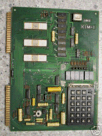
|
| 1976 |
 David Jackson founds Altos Computer Systems (Januar).
David Jackson founds Altos Computer Systems (Januar).

|
|
 Stephen Wozniak & Steve Jobs finish work on a computer circuit board, that they call the
Apple I computer (March).
Stephen Wozniak & Steve Jobs finish work on a computer circuit board, that they call the
Apple I computer (March).
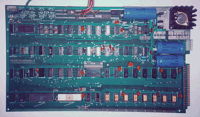
|
|
 Stephen Wozniak offers his new computer (Apple) to Hewlett-Packard, who reject it
as a non-viable product.
Stephen Wozniak offers his new computer (Apple) to Hewlett-Packard, who reject it
as a non-viable product.
|
|
 Steve Jobs & Stephen Wozniak
Steve Jobs & Stephen Wozniak
 found Apple Computer
found Apple Computer
 on April Fool's Day (April, 1).
on April Fool's Day (April, 1).
|
|
 Intel introduces the 5 MHz 8085 microprocessor. Speed is 0.37 MIPS. It uses 6500
transistors, based on 3-micron technology. It supports an 8-bit bus, and operates on a
single 5-volt power supply (March).
Intel introduces the 5 MHz 8085 microprocessor. Speed is 0.37 MIPS. It uses 6500
transistors, based on 3-micron technology. It supports an 8-bit bus, and operates on a
single 5-volt power supply (March).
|
|
 National Semiconductor releases the SC/MP 8-bit microprocessor, providing early
advanced multiprocessing (April).
National Semiconductor releases the SC/MP 8-bit microprocessor, providing early
advanced multiprocessing (April).
|
|
 At the PC '76 conference at the Shelbourne Hotel in Atlantic City, Processor Technology
unveils the Sol-20 microcomputer. The Sol-20 uses an Intel 8080 processor, and is
sold in a kit form (June).
At the PC '76 conference at the Shelbourne Hotel in Atlantic City, Processor Technology
unveils the Sol-20 microcomputer. The Sol-20 uses an Intel 8080 processor, and is
sold in a kit form (June).
|
|
 Gary Kildall and wife Dorothy McEwen found Intergalactic Digital Research.
The name is soon shortened to Digital Research.
Gary Kildall and wife Dorothy McEwen found Intergalactic Digital Research.
The name is soon shortened to Digital Research.

|
|
 Advanced Micro Devices and Intel sign a patent cross-license agreement, giving Advanced Micro
Devices the right to copy Intel's processor microcode and instruction codes.
Advanced Micro Devices and Intel sign a patent cross-license agreement, giving Advanced Micro
Devices the right to copy Intel's processor microcode and instruction codes.
|
|
 IBM develops the ink jet printer.
IBM develops the ink jet printer.
|
|
 U.S. Robotics is founded, in Skokie, Illinois.
U.S. Robotics is founded, in Skokie, Illinois.

|
|
 IMSAI begins shipping the IMSAI 8080 microcomputer.
IMSAI begins shipping the IMSAI 8080 microcomputer.
|
|
 The bus of the Altair is named (or renamed) the S-100 bus.
The bus of the Altair is named (or renamed) the S-100 bus.
|
|
 Zilog releases the 2.5 MHz Z80, an 8-bit microprocessor whose instruction set
is a superset of the Intel 8080.
Zilog releases the 2.5 MHz Z80, an 8-bit microprocessor whose instruction set
is a superset of the Intel 8080.

|
|
 Digital Research copyrights the CP/M operating system (May).
Digital Research copyrights the CP/M operating system (May).
|
|
 Texas Instruments introduces the TMS9900, the first 16-bit microprocessor.
The microprocessor implements the 16-bit architecture used on the TI 990 minicomputer (June).
Texas Instruments introduces the TMS9900, the first 16-bit microprocessor.
The microprocessor implements the 16-bit architecture used on the TI 990 minicomputer (June).
|
|
 Commodore International buys MOS Technology (October).
Commodore International buys MOS Technology (October).
|
|
 The tradename Microsoft is registered (November).
The tradename Microsoft is registered (November).
|
|
 Michael Shrayer completes writing the Electric Pencil word-processing program
for microcomputers (December).
Michael Shrayer completes writing the Electric Pencil word-processing program
for microcomputers (December).
|
|
 Shugart Associates announces its Model SA400 5¼ inch minifloppy disk drive for
US$390. Disk capacity is 110 KB. The disk size is based on a cocktail napkin which a customer
requested, rather than the usual eight inch size (December).
Shugart Associates announces its Model SA400 5¼ inch minifloppy disk drive for
US$390. Disk capacity is 110 KB. The disk size is based on a cocktail napkin which a customer
requested, rather than the usual eight inch size (December).
|
| 1977 |
 Donald Knuth
Donald Knuth
 begins work on TEX
and METAFONT
begins work on TEX
and METAFONT
|
|
 4096-bit static bipolar RAM
4096-bit static bipolar RAM
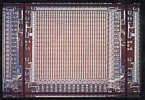
|
| 1978 |
 Seymour Rubinstein invents WordStar.
Seymour Rubinstein invents WordStar.
|
| 1979 |
 64k dynamic RAM
64k dynamic RAM

|
|
 Daniel Bricklin
Daniel Bricklin
 presents VisiCalc.
presents VisiCalc.
|
|
 Duke University and University of North Carolina (UNC): USENET
Duke University and University of North Carolina (UNC): USENET
|
|
 Motorola announces the 68000 microprocessor.
Motorola announces the 68000 microprocessor.
|
|
 Intel introduces the i8088 microprocessor.
Intel introduces the i8088 microprocessor.

|